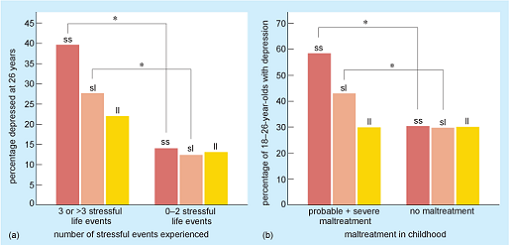6.1 The serotonin transporter gene and vulnerability to stressful life events
One approach that genetic epidemiologists initially took was to see if mood disorders such as depression could be linked to the kinds of genes people carry. (Genetic epidemiologists are epidemiologists who study the role of genetic factors and their interactions with environmental factors in the occurrence of diseases or disorders.)
As you have seen previously, serotonin (also known as 5-HT) has been the focus of much attention as a modulator of mood, and a lack of serotonin has been suggested as a factor in the development of depression. (5-HT (5-hydroxytryptamine) is the chemical name for serotonin, so 5-HTT is the ‘serotonin transporter’: the second T stands for ‘transporter’.) Indeed, selective serotonin reuptake inhibitors (SSRIs) are widely used as ADMs. Thus a protein that is involved in serotonin reuptake, the serotonin transporter protein coded for by the 5-HTT gene, has attracted much interest from genetic epidemiologists.
Before going any further, it would be a good idea to read paragraph 1 in Box 3, to understand what genes are and how they work to produce proteins. (You do not need to read paragraphs 2 and 3 just yet; you will directed to read these in a later section.)
Box 3 Genes, gene expression and epigenetic mechanisms
- The human body contains around 100 trillion cells. Most cells contain an enclosed central area, the nucleus, which contains structures called chromosomes. In humans the nucleus typically contains 23 pairs of chromosomes. One chromosome in each pair is from the mother while the other is from the father. Each chromosome contains a long strand of DNA (short for deoxyribonucleic acid – you do not need to remember this!). The DNA contains the code for genes, written in chemical ‘letters’. Genes are the templates for proteins – that is, they contain instructions for putting together protein molecules from building blocks called amino acids. (You read about an amino acid, tryptophan, in Section 4.3) Protein molecules are vital to life – they build and maintain our cells, including our neurons, and hence our brains and bodies.
- To have an effect on the phenotype, a gene must actually be used to make the protein it codes for, a process called gene expression. A cell does not use every gene it contains to make a protein. Almost every cell in an individual contains the same genes, but different cells express different selections of genes. Such selective gene expression is what makes a muscle cell (for example) different from a neuron. The genes that are not expressed are said to be ‘silenced’.
- The main way to silence a gene is to physically block access to it so that the protein it codes for cannot be made. Methyl groups (a kind of chemical present in the body) are often used by cells to create such a barrier and block access to genes, a process called methylation. Access to a silenced gene can also be restored. Sometimes this can be done by removing the obstructing methyl groups (i.e. by demethylation). At other times it can be done by adding another chemical, acetyl groups, that facilitate greater access to genes. This process is known as acetylation. Such ‘silencing’ and ‘de-silencing’ mechanisms are examples of epigenetic mechanisms. The word ‘epigenetic’ means ‘above or beyond genes’ and is used to refer to the way the expression of genes can be altered as described above.
The 5-HTT gene codes for the serotonin transporter protein – that is, it provides cells with the ‘instructions’ needed to make the protein. As a serotonin transporter, the protein is responsible for the reuptake of serotonin into the presynaptic cell after it has been released into the synaptic gap to signal to the adjacent neuron (recall Figure 9).
The number and activity of the serotonin transporters determines the length of time that serotonin will remain in the synaptic gap before reuptake into the presynaptic cell. The gene for the serotonin transporter comes in two variants, a short form (s) and a long form (l). Each person carries two copies, or alleles, of the gene, one from each parent. The ‘s’ version produces less of the functional protein than the ‘l’ one.
As mentioned above, each individual carries two alleles, one allele (‘s’ or ‘l’) from the father and one (‘s’or‘l’) from the mother. What possible combination of alleles (or genotype) could an individual have?
The combinations are ss, ll or sl.
Genetic epidemiologists wondered if carrying one of the forms, ‘l’ or ‘s’, made people more likely to develop depression. However, doing epidemiological studies correlating the carrying of one or other of the 5-HTT gene variants with the occurrence of depression failed to show a link.
Caspi et al. (2003) wondered if taking into account the level of stress people had experienced would clarify the picture. They determined which allele combinations were carried by each of the 847 participants in a long-term study (the Dunedin study, which followed participants from birth), along with the number of major stresses they had experienced. When participants were 26 years old, the researchers evaluated how many stressful events they had experienced in the last 5 years, and whether or not they had depression. Caspi et al. (2003) found that people with either one or two short alleles (i.e. ‘sl’ or ‘ss’) were significantly more likely to develop depression following stress than people with two long alleles (‘ll’) (Figure 13a).
Did it matter how many stressful events participants had experienced in the last 5 years?
Yes – 5-HTT genotype was associated with likelihood of depression only if three or more stressful events had occurred (Figure 13a).
Similarly, the researchers found that those who had experienced childhood maltreatment between 3–11 years were significantly more likely to be depressed between 18–26 years if they had the ‘ss’ or ‘sl’ genotype than if they had the ‘ll’ genotype. There was no effect of 5HTT genotype if maltreatment had not occurred (Figure 13b).

The importance of this study lies in its demonstration that genetic factors may not directly ‘cause’ disease, but may instead mediate responses to environmental factors such as stress (Caspi et. al. 2003).
More than two-thirds of people apparently carry at least one short allele of the 5-HTT gene. Does this mean they are all likely to get seriously depressed?
No, carrying the ‘s’ allele itself does not mean you are likely to get depressed. What it does mean is that the chances of getting depressed may be higher compared to people who have two long alleles (‘ll’), if a person with two or one short alleles has many stressful experiences.
While an effect of carrying these combinations might exist (though the results of studies to replicate this finding are mixed to date – Risch et al., 2009; Hammen et al., 2010), it is not known how the effects might come about.
The ‘s’ allele of the 5-HTT gene causes decreased production of the functional protein – that is, fewer serotonin transporters are produced. What might happen if fewer serotonin transporters are available?
The rate of reuptake of serotonin might be reduced, since these transporters are involved in reuptake of serotonin.
However, successful treatment of depression has often involved serotonin reuptake inhibitors, so it is puzzling that decreased production of the transporter responsible for this reuptake seems to exacerbate depression. It is evident that much is still unclear about precisely how serotonin or serotonin reuptake inhibitors might act to affect mood.
